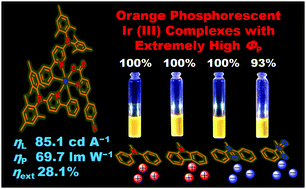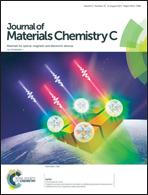Novel iridium(iii) complexes bearing dimesitylboron groups with nearly 100% phosphorescent quantum yields for highly efficient organic light-emitting diodes†
Abstract
A series of cyclometalated iridium(III) complexes, Ir-B-1, Ir-B-2, Ir-B-3, and Ir-B-4, were synthesized with the 2-phenylpyridine (ppy) type main ligand possessing a dimesitylboron group and the auxiliary ligand containing other main-group element units showing unique charge injection/transporting features. Their thermal stability, photophysical and electrochemical properties, and electroluminescent (EL) performances have been characterized. Time-dependent density functional theory (TD-DFT) calculations were carried out to study the photophysical properties of these complexes. All these complexes can emit intense orange phosphorescence with extremely high quantum yields of nearly 100% measured in neat films at room temperature. Moreover, the solution-processed organic light-emitting devices (OLEDs) using these complexes as orange emitters can show very high EL efficiencies with the maximum luminance efficiency (ηL) of 85.1 cd A−1, corresponding to a power efficiency (ηP) of 69.7 lm W−1 and an external quantum efficiency (ηext) of 28.1%.



 Please wait while we load your content...
Please wait while we load your content...